Original Owner: A 12-year-old saves to buy a new MGB at 16
Welcome to Original Owner, a series showcasing—you guessed it—people who bought a classic car new and still own it. The cars don’t need to be factory-original, just still in the hands of the first owner and still getting driven. Got a tip? Email tips@hagerty.com —Ed.
At 16 years old, Peter Cosmides bought a 1975 MGB roadster brand-new with funds he’d earned working since he was 12. The purchase had fulfilled an obsession sparked when he was a very young boy. After buying the iconic British roadster, Cosmides would find it steering his life’s course in unexpected ways.
“Owning the MG shaped my life as far as my hobby, my friends, and even my vocation,” Cosmides recalls. “The friends I have today are all people that have MGs or other British cars that I’ve met over the years. In 2020, I retired from running a British car restoration business for 14 years.”
Before all that happened, the MG was just his fun daily driver. He wasn’t afraid to take it on long road trips, either: A year after buying it, Cosmides drove the green roadster cross-country from his home at the time in Valley Stream, New York on Long Island to attend Arizona State University.

“My girlfriend, Anne, lived with me there for a time,” he says. “She was my high school sweetheart. We got married in 1980 and are still married. She knew I was already well ensconced in the MG world when she came along.”
The MG would serve as the newlyweds’ only car for several years. It even took them to the laundromat.
“By around 1980, we bought something else, and the MG became the second car,” he says. “I started taking it to British car shows, and I’ve been going ever since. I made several trips to Florida in it over the years, too.”
MG family
The MGB, which now has about 100,000 miles, has acquired MG siblings over the years. When we spoke with Cosmides in July of 2023, he and his wife had just returned to his southern New Jersey home from a 1350-mile road trip in one of them, a 1996 MGF. The automaker’s final sports car, the MGF was a mid-engine roadster never imported to the United States.
Cosmides also owns one of the 2600-or-so MGB GT V8 models built from 1973 to 1976, most of which are right-hand drive models for the U.K. market. To make this captivating model, MG replaced the B’s four-banger with the former Buick 3.5-liter aluminum V-8 that British Leyland had come to own and use in a variety of Rover cars as well as in the Range Rover SUV. Not much heavier than the four-cylinder model, the MGB GT V8 could hit 60 mph from zero in 7.5 seconds. This engine would also find its way into the 1978–80 Triumph TR8 and some British boutique sports cars, including the Morgan Plus 8.
MG pilgrimage
The summer 2023 road trip in the MGF had been something of a pilgrimage for Cosmides, a trip which he and his wife took with friends driving an Austin Healey. The main stop was Petersburg, Virginia, the home of well-known British auto parts supplier Moss Motors, which was hosting a cars and coffee event to celebrate its 75th anniversary.
Cosmides’ connection to Moss went well beyond buying parts for his MGs over the years. In the ’80s, he had worked for the giant parts seller, first in California and then at its warehouse in Rockaway, New Jersey, an operation that later moved to Virginia.
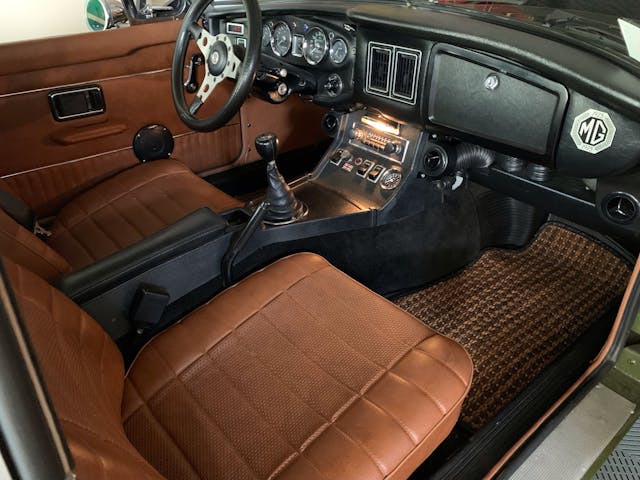
“I was the first employee in their New Jersey facility,” he recalls. “I was there only a couple of years. After that, I worked for Federal Express for about 20 years.”
When the Moss Motors celebration ended, Cosmides and his wife continued southward to North Carolina to pick up a hardtop for the MGF before returning home to New York.
“The MGF was a much more modern car than the MGB, which had really become an antique toward the end of production,” Cosmides acknowledges. “They’d never really improved on it while struggling to meet any regulations that came along.”
Still, he loves his “antique” as much today as he did on the day he bought it.
A boy’s MG obsession
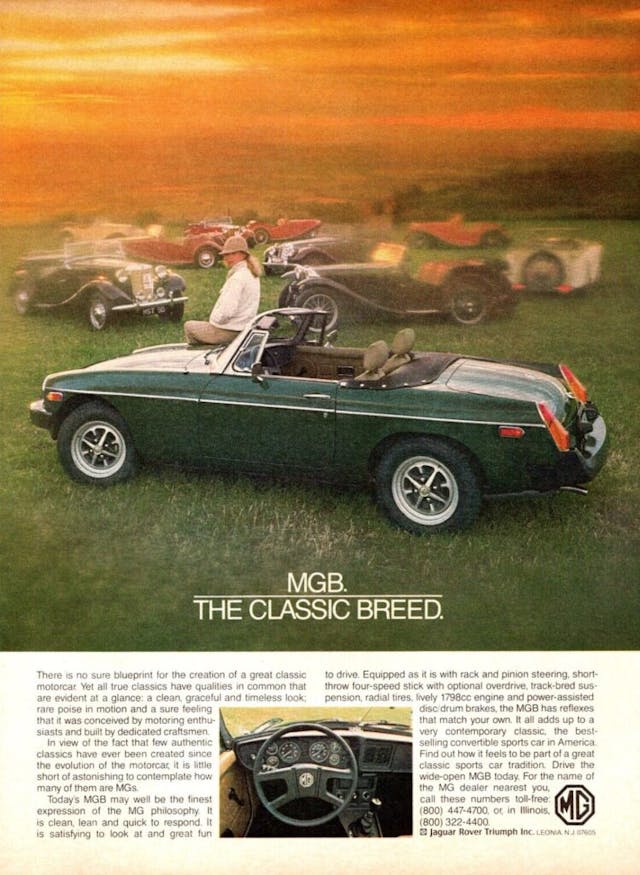
Working for the largest British car parts supplier had been, if only briefly, something of a dream job for a young man whose infatuation with the island nation’s sports cars had begun when he was a boy.
“When I was five, my uncle bought a 1962 Austin Healey Sprite Mk. II,” he says. “That was the twin to the MG Midget. I used to sit in that car and pretend I was driving. I became kind of a sports car enthusiast right then.”
When he turned 12, Cosmides already had his heart set on buying a new MGB in time for getting his driver’s license. He began working in earnest to achieve that goal. From 1972 through 1975, he was a mechanic at the local Schwinn bicycle store. During summers, he also worked for the local school district as a janitor.
The work paid off. By spring 1975, when he was still 16, Cosmides had saved $3800 (about $21,500 today). “But the MG was $4800,” he remembers. “My father was kind enough to throw in that other thousand dollars. And so, I bought myself a brand-new MGB.”
Accompanied by his father, he ordered the MG from Road-Track Imports on Burnside Avenue in Inwood, New York, in May 1975. Today, the same corner building houses several businesses, including a smoke shop. The old service area is today a tire business.
The car arrived at the dealership in August, in time for Cosmides’ 17th birthday—but it was the wrong color.
“We had placed an order for a blue one, but a green one came in instead. I took it anyway, and I’m glad I did. It’s a great color.”

Factory basics: MGB
Years before the British pop music invasion, there was the sports car invasion, with MG as one of the leaders. In 1955, the company replaced the TF, the last of its 1930s-styled “T” models, with the sleek MGA. The new car became an instant hit. Through 1962, MG made about 101,000 of them, with most exported to the U.S., the largest market for other British sports cars, as well.
The A’s successor would do even better and, like certain British rock bands, it would stick around much longer than seven years. Introduced at the Earls Court Motor Show on September 20, 1962, the MGB ushered in a wave of modernity over the MGA, including a unitized body structure replacing the A’s body-on-frame setup.
The MGB’s handsome in-house design showed more than a passing resemblance to the Pininfarina-designed 1960 Ferrari 250 GT Cabriolet Series II, which certainly added to the cheaper roadster’s appeal. The B boasted a roomier, more comfortable cockpit than the A, including roll-up windows instead of the A’s side curtains.
Under the hood, the B-series OHV inline four-cylinder engine birthed by Austin in 1947 grew from the MGA’s 1.6-liter to 1.8 liters (1798 cc, to be precise), with 92 horsepower at 5400 rpm and 106 lb-ft of torque at 3000 rpm (SAE gross). These were good numbers for a 2200-pound car. The ’65 gained a stronger, five main-bearing crankshaft, and MG boosted output slightly to 95 hp and 110 lb-ft.

The four-speed manual transmission (non-synchro first gear) and suspension carried over from the MGA, using A-arms with coil springs and lever shocks up front and a solid axle on multi-leaf springs with lever shocks in back. An optional front antiroll bar later became standard. Steering was unassisted rack-and-pinion. Wheels measured 14 x 4.5 inches.
The early MGB could do 0 to 60 mph in about 12 seconds and crest 100 mph. Laycock de Normanville overdrive was a $175 option that could lower revs in highway driving. A pretty and practical MGB GT hatchback coupe, with a roofline shaped by Pininfarina, joined the roadster in 1965 (1966 in the U.S.) and proved popular.
The MGB got a fully synchronized transmission for 1968, and the air injection pump emission-control system continued to be available, as well. In that year’s road test of an MGB, Road & Track praised its sports car reflexes and pure driving joy but noted an “outdated character.” The MGB roadster’s price was about $2900 that year.
To offer a higher-performance choice, MG created the 1968–69 MGC by dropping in a 3.0-liter Austin inline six. The 145-hp six chopped the 0-to-60 time down to 10 seconds, but the engine was more than 200 pounds heavier than the four-cylinder. The added weight dampened handling agility and made the MGC’s steering very heavy. Just around 9000 MGC roadsters and GT coupes were made, including for the U.S. The later MGB GT V8 was a far better package.
Malaise MG
The MGB roadster became a popular club racer, winning numerous SCCA D- and E-Production championships in the mid- and late-’70s with the Huffaker Engineering team sponsored by British Leyland. The ’70s were not kind to the production MGB, though. Stiffening U.S. emissions regulations took a bite out of power for all cars, and the MG’s pushrod four was hit especially hard.
Output for the 1975 MGB was down to 65 hp (SAE net) and 92 lb-ft of torque at 2500 rpm. The engine traded its dual SU carburetors for a single Zenith, and the car gained a catalytic converter. To meet U.S. bumper and lighting regulations, the MGB added ride height and sprouted big, black polyurethane bumpers in mid-1974. The changes pushed weight about 200 pounds higher than the earlier cars. The MG’s 0-to-60 time crept up to about 14 seconds, though a Porsche 914 with the standard 1.8-liter VW air-cooled flat-four did no better.
The MGB ended in October 1980, when the Abingdon, England, plant that built it closed. By the end, MG had built some 390,000 MGB roadsters and about 125,000 GT coupes. The last roadsters cost $8000 in the U.S., and a Limited Edition model with special paint and features was $8600. Henry Ford II bought the last one imported here. The MGB would remain the world’s biggest-selling small sports car until the Mazda MX5 Miata surpassed it in 2000, as noted by Guinness World Records.

Peter’s MG
Cosmides says his MG held up well, but by 1999 he knew he’d have to address rust in the rocker panels.
“I took it apart and fixed the rust myself and then stripped the car down completely. I then trailered it to a friend in Buffalo, New York, who paints cars. He understands the car and the hobby. I didn’t want to just go to a local body shop to have them paint a classic car.”
One small modification was adding the factory ‘Special Tuning,’ or ST, spoiler. The engine did not need a full rebuild, just the cylinder head and carburetors, plus attention to other components. Cosmides would later replace the MG’s four-speed transmission with a five-speed from the Datsun 280ZX.

“The five-speed is a popular conversion,” he says. “There’s a kit available, and you source the gearbox. It’s a straightforward installation. That was the smartest thing I ever did to the car. The five-speed made a huge difference on the highway. I was able to cruise more comfortably.” [Fifth gear in this transmission is a 0.745:1 overdrive, which significantly reduced the little four-cylinder engine’s revs at highway speeds.]
“A bonus is that the gearbox will come out by itself from underneath the car, which is not something you could do with an MGB four-speed,” Cosmides explains. “If you needed a clutch or any kind of transmission work, you had to pull both the engine and transmission.”
MG memories
Hagerty: When you were saving money for the MG, did you have any thoughts about buying a used model? There were plenty around at that time.
PC: It never occurred to me. I just had my sights set on a new one.
Hagerty: Did any other sports cars catch your eye as a teen?
PC: I had pictures of other cars on my bedroom wall. I knew the Alfa Romeo and Fiat 124 Spiders, of course, and the Fiat X1/9 was on the market by then. Of all things, I liked the Saab Sonnet III, but it was way too quirky. My father would never have gone for that. It was bad enough that I wanted an MG! He’d say, ‘Just buy a Chevy Vega and save a third of the price of an MG.’
Hagerty: When did you install the five-speed?
PC: Not until 2011. I was preparing to take a cross-country trip. A bunch of MG owners were going from the East Coast out to Reno, Nevada, to attend a big MG meet, doing the drive on U.S. Route 50. The trip was 6000 miles round-trip, including going on from Reno to San Francisco.
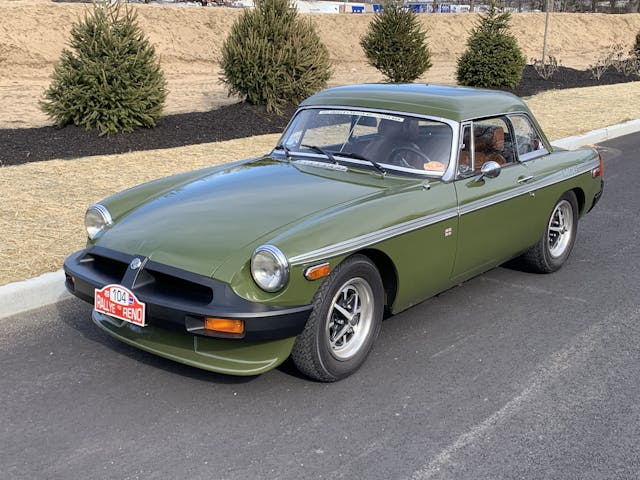
Hagerty: How did the MG do over that distance?
PC: It was trouble-free on that trip. My son, who was in his late 20s at the time, flew out to meet me in Reno. He rode with me until I got to Phoenix and then flew back home. Then I was on my own. Some of the other MG owners in the group had arranged for a car carrier to return their cars to various places along the way back East, but I drove mine. I went down the Pacific Coast Highway to Los Angeles and then across US-40.
Hagerty: What made you decide to open a British car shop?
I’d been working for Federal Express around 20 years, and I had an epiphany that I really didn’t want to do that anymore. I decided to open a repair facility to work on MGs, starting slowly in my garage, working on cars of people I knew. For the next 14 years, I had a shop that specialized in British cars. We did repairs and restorations. A good percentage were MGs.
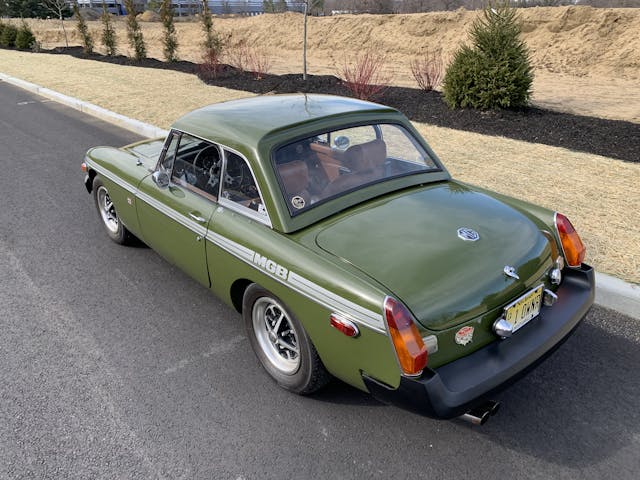
Hagerty: Where did you pick up your skills to work on these cars?
PC: From working on my own. I had no formal training. It was like that bumper sticker you see on old Land Rovers that says something like, ‘Land Rover: turning owners into mechanics for 60 years.’
If you had an MG, you pretty much had to learn how to work on it. You didn’t use it without eventually having to give it some help. I think that’s what attracts a lot of people to British cars, and many classic cars in general. You get a sense that the car needs you, that you’re in a partnership.
For Peter Cosmides, that partnership endures.
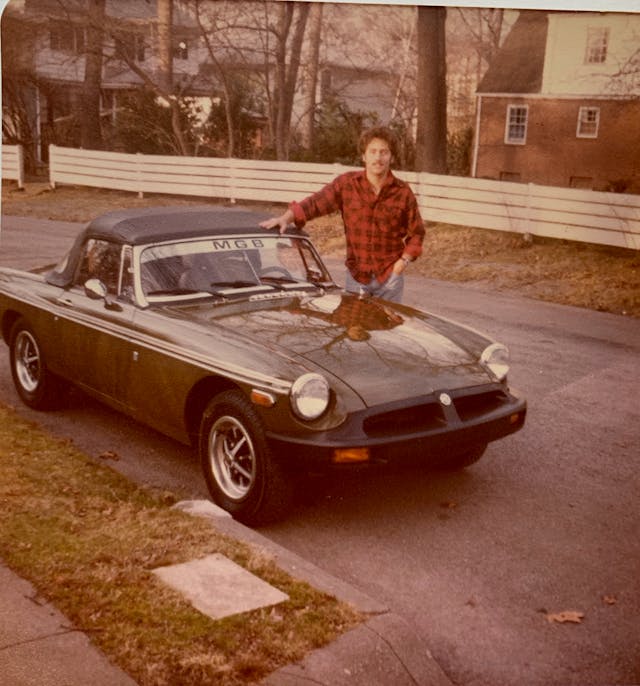
__
Car: 1975 MGB roadster
Owner: Peter Cosmides
Home: Moorestown, NJ
Delivery date: August, 1975
Miles on car: ~100,000
Are you the original owner of a classic car or do you know someone who is? Send us a photo and a bit of background at editor@hagerty.com — you might get featured in our next installment!
***
Check out the Hagerty Media homepage so you don’t miss a single story, or better yet, bookmark it. To get our best stories delivered right to your inbox, subscribe to our newsletters.




Applause to the owner, this story and his father for recognizing the effort and chipping in that bit to make it happen.
Incredible story. Being about the same age I would have been an absolute hanger-on to do the same. My want at the time was the Fiat Spider which eluded me, but for the best as mechanical skills never went past my bicycle.
I knew Pete very well. We met though our MGBs and went on many trips including going the Canada! He’s an amazing cat!
Wow, hello Matt after all these years. Hope your well. Still have your white MGB?
Hey Pete!! Hope all is well with you and yours! Unfortunately no I no longer have the MGB… the winters in New England took their salty revenge… but I’m once again looking!
What a great story, never had a great interest for the MG, being British I don’t know why but its good to learn of others passions Pete, well done 👍
Great story. And I loved seeing the classic MG ads of my former boss and mentor Marce Mayhew, produced when he was creative director at Bozell and Jacobs.
What a cool story. I look forward to Hagarty publishing many more.
Great story. My favorite is the MGB GT V8.
My MGB story is sort of parallel. I bought a Harvest Gold MGB new in 1974, last of the chrome bumper cars, and still have it. Now almost 50 years later the B is still in original condition, with factory paint, interior and soft top. It has never been repainted or had any metal work. The car is totally rust free, I know that is hard to believe, but it is. The car has covered just over 100,000 miles so it is a going concern, not a museum piece. The parallel continues with my owning a 1996 MGF. It looks like it might even be the same colour. Back in 1988 I bought a 67 MGB/GT and rebuilt it myself from the ground up, BRG, with black interior/white piping, overdrive and wire wheels. I still have it. A friend of mine and I are currently rebuilding a 1947 MG TC. We bought it a few years back, it was almost totally disassembled. We needed a couple of trailer trips to lug it all back to our secret hideout.
More parallels!
I bought my first MGB, a new 1973 model at age eighteen, and besides co-signing, my dad kicked in $950.
It too led to a life of British cars, including a total of sixteen (16) additional MGBs & BGTs, including the ’67 GT undergoing restoration on the rotisserie sitting behind me.
I worked for a while in a place called Austin-Healey West in San Francisco, and still have the ’57 Healey 100/6 2-seater I bought from the owners wife.
In the year 2000, I shifted gears a bit, and got involved with BMW M Roadsters. January 1st, 2005 saw the formation of Sports Cars Plus, LLC to produce and install a reinforcement for the M Coupes/Rdstrs (’98-’02 models). A couple of years ago, I stopped doing the installations after some 100+ cars, and concentrated on just producing the kit for other shops to install.
Nowadays I’m retired__save for the above forementioned part__and just play with my own cars, the Healey, MGB GT, a pair of M Rdstrs (’99 & ’01) and a twinscrew supercharged ’99 M Coupe in the shop behind the house.
I know how Pete feels about his MG. I’m on my fourth one, a 75 B that I’ve had for 24 years. My first car was a 66 B GT. Then I had a 64 Midget and a new 77 B.
The subject’s story and mine are very similar in ways. I started working at 13 to save for a car. I turned 16 in 1975 and wanted a new MGB. Sadly my funds fell short also, so I asked my dad to kick in some money. He agreed, but not if I bought a ‘B’. He had read or heard about them rolling over, which I thought was nonsense, but was in fact true for some 1975 models, due to the raised ride height to accommodate the new headlight regs. I ended up with a Datsun. I loved that car, but it was no MG. As an adult, I finally got a ‘B’, albeit a very used 1967. In many ways it was a better car than a ’75 would have been especially for a new driver, and I kept it for many years before selling it to my brother, who drove it into the ground and sold it for almost nothing. I wonder how my life would have differed had dad gone with an MGB?
A great story and life adventure for Peter. Thanks for sharing.
At 16, I wanted a Sunbeam Tiger real bad, had books on it and was even taking measurments to see if I would fit in it, but was not practical up North. Also a 62 Corvette was on my mind but they were still to new and high insurance cost. I finally setteled for a gorgeous 57 Chevy Bel Air conv, 283 all black with red interior and white top and I wish I still had it today.
Pete was more ambitious than I was as a kid. I waited until I graduated college, did my time in the Army and got a regular job. As soon as I could I ran out and ordered a new Porsche 356 Cabriolet. Before it arrived,, I was out of work for a few months while one of the unions in the company went out on strike long enough that I burned through enough of my savings I could no longer afford the new 356. Instead, I bought a new MGB for only $2600. It was BRG with black top & interior. In the north Jersey environment, it wasn’t particularly visible, as a result I was hit 24 times in 2 years. Well, I did love the MGB and ended up owning 4 of them over the years. The last was my daily driver and occasional vintage racecar until around 2004. Loved and now miss that car. Without a/c it was tolerable in New England summers and with an engine modified by Fab-Tek was able to hit 120 mph on the back straight at Watkins Glen.
I loved reading this story! Well done, Pete!!!!
Nice read Pete, I remember your enthusiasm from my 30+ years at Moss Motors. You certainly would have been a great career member of the team but don’t recall why you left? Chris K. would have known.
While I bought my first MG TD at 17, sold it a year later to buy a TC, now have my 2nd TC and 3 other road worthy MG’s. Still having fun with them, 50+ years on. Cheers, Chris Nowlan